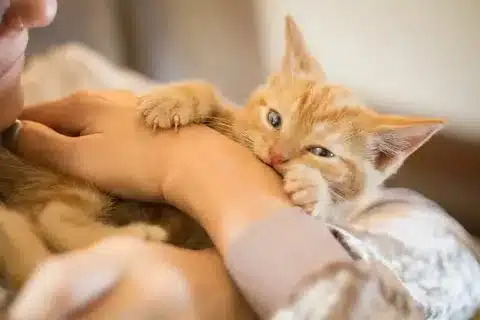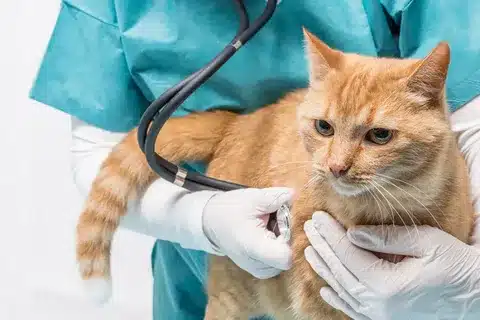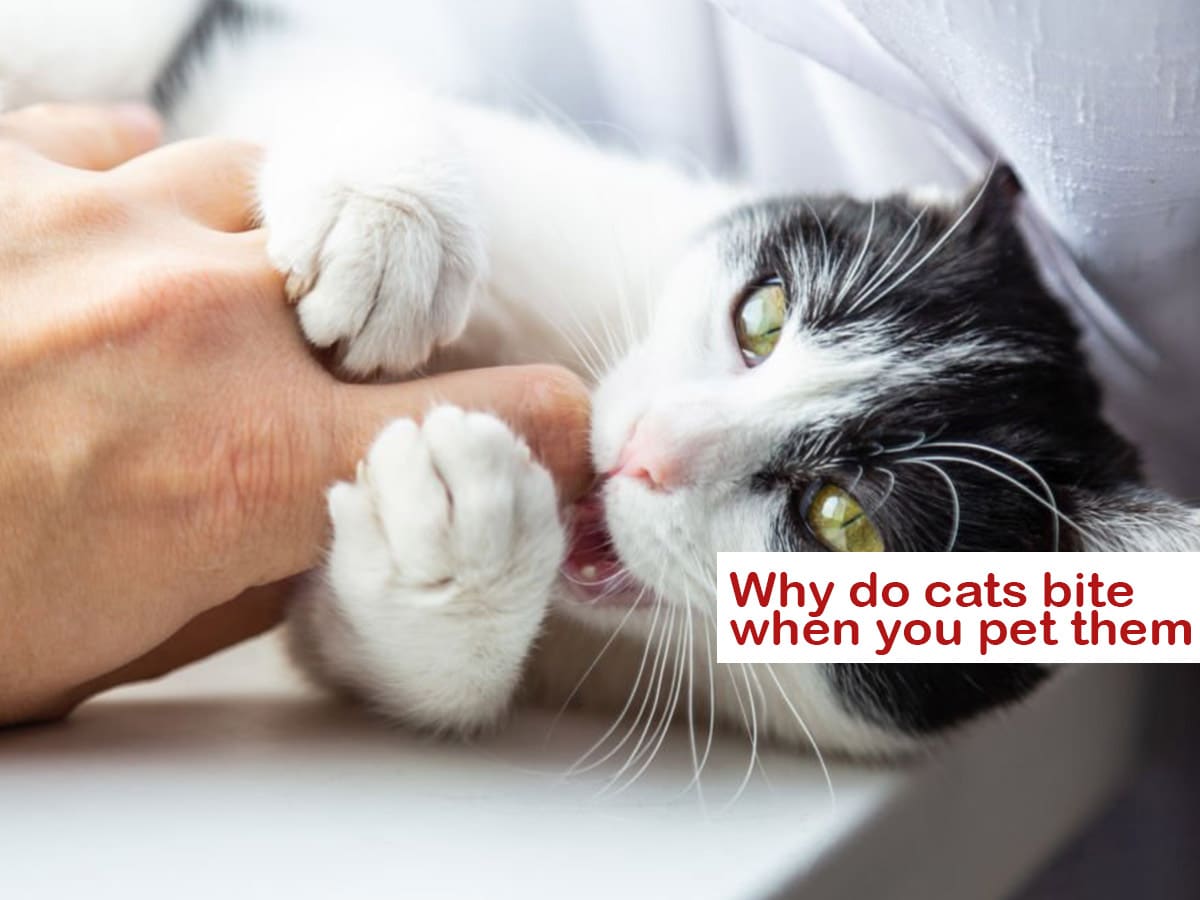When your cat chooses to give you a soft bite as a way of expressing how much it loves you, have you ever been faced with an overwhelming mixture of affection and confusion? Did you ever think, Why do cats bite when you pet them?
Cat lovers often find themselves in this curious scenario: “Why do cats behave like this?” But fear not, fellow pet lovers. In this concise guide, we unravel the mysteries behind these love bites and find the various reasons your cat may engage in this behavior.
Fostering a happy connection with your cat requires that you understand the reasons behind their biting, whether they be playful antics, underlying worries, or just a simple show of affection.
Come along as we explore the subtleties of feline behavior, offering understanding, answers, and professional advice on how to interpret the sometimes-nippy language of love. Together, let us explore the fascinating realm of cat bites.
Understanding Cat Love Bites: Why do cats bite when you pet them?
Our furry companions are renowned for expressing themselves in ways that confound us (or occasionally result in unanticipated bite marks). Although an unexpected bite during an apparently content petting session can be perplexing, do not panic! Let us delve into the intriguing realm of “cat love bites,” comprehend their significance, and learn how to deal with these endearing—yet occasionally uncomfortable—movements.
- Not all bites are created equal! Gentle, playful nips without aggression might be your cat’s way of showing affection. Observe their overall demeanor: a relaxed posture and playful swats suggest a harmless “love bite.”
- Be mindful of individual differences. Some cats dislike being petted in specific areas, while others have a higher tolerance. Respect their boundaries and stop petting when they seem overstimulated.
Common Reasons Why Cats Bite:

Cats, known for their independent and mysterious character, communicate through a number of behaviors, including biting. Understanding the common reasons why cats bite is critical for any cat owner looking to cultivate a strong relationship with their feline companion.
| Reason for Cat Biting | Description |
|---|---|
| Love Bites | Cats express affection through gentle nibbles, commonly known as “love bites.” These bites are typically soft and serve as a unique form of feline endearment. |
| Fear and Anxiety | Fearful or anxious cats may resort to biting as a defensive mechanism. Identifying sources of stress and providing a secure environment can help alleviate such biting behaviors. |
| Petting and Biting | While petting is generally enjoyable for cats, some may become overstimulated, leading to biting. Understanding your cat’s body language and recognizing signs of discomfort can prevent incidents. |
| Frustration | Cats may bite out of frustration, particularly when their needs or desires are not met. Providing mental and physical stimulation, along with a conducive environment, can curb biting. |
| Inappropriate Play | Playful bites are a common part of feline interaction. Teaching appropriate play behavior from a young age and redirecting aggressive play can minimize biting incidents. |
| Social Pressures | Changes in the environment or the introduction of new pets can lead to territorial stress. Biting may occur as a response to these social pressures. |
| Illness or Pain | Cats in pain or discomfort may resort to biting as a way to communicate distress. Regular veterinary check-ups can help identify and address underlying health issues. |
Addressing Cat Biting Behavior:
Cat-biting behavior can pose challenges for cat owners, but with the right understanding and approach, it’s possible to address and modify this behavior. Here are effective strategies to tackle cat biting and foster a harmonious relationship:
Identify Triggers:
Start by observing when and where your cat tends to bite. Is it during specific activities, such as play or grooming? Understanding the triggers can help you address the root cause.
Provide Proper Play Outlets:
Cats have a natural instinct to play. Ensure your cat has appropriate toys to channel their energy. Interactive Pet toys and regular play sessions can help reduce the likelihood of play-induced biting.
Avoid Overstimulation:
When caressing your cat, observe its body language. Give your cat a break if you see symptoms of overstimulation, including a twitching tail or flattened ears, since this will help to avoid biting.
Positive Reinforcement:

Reinforce positive behaviors with treats and affection. When your cat engages in non-biting behaviors, reward them, reinforcing that good behavior is appreciated.
Use Deterrents:
Employ deterrents, such as bitter-tasting sprays, on objects or areas where your cat tends to bite. This can discourage biting by associating it with an unpleasant taste.
Regular veterinary check-ups:

Ensure your cat is in good health by scheduling regular veterinary check-ups and a proper diet plan for your furry friends. Addressing any underlying health issues can prevent pain-related biting.
Training Techniques:
To deter biting, use positive reinforcement training methods. When your cat bites, refocus their attention on appropriate toys or activities to encourage positive behavior.
Create safe spaces:
Provide your cat with designated safe spaces where they can retreat when feeling stressed or overwhelmed. Having these safe zones can reduce the likelihood of defensive biting.
Consult with a professional:
If biting behavior persists or becomes more aggressive, seeking advice from a professional, such as a veterinarian or animal behaviorist, can provide tailored solutions for your specific situation.
Patience and consistency
Changing behavior takes time. Be patient and consistent in your approach to addressing cat biting. Consistency in positive reinforcement and training is key to success.
Expert Insights and Author Contributions:
Expert views are vital when it comes to comprehending cat behavior and addressing biting tendencies. This section brings together insightful views from seasoned industry leaders. These observations, which were medically examined by Laura Fontana, DVM, and written by renowned veterinary sciences expert Dr. Joshua Montgomery, offer a comprehensive understanding of the complex subtleties of cat biting behavior. Laura Fontana’s veterinary background guarantees accuracy and dependability, and Dr. Montgomery’s expertise provides readers with a thorough understanding. By providing information, useful advice, and a deeper understanding of the world of feline communication, their combined efforts hope to empower cat owners and promote a happy, healthy relationship between them and their cherished feline friends.
Conclusion
Think of your cat’s bites as tiny messages waiting to be decoded. Whether it’s a sweet love bite or a signal of discomfort, each nibble tells a story. This guide is your key to understanding these messages and deepening your connection with your furry friend.
Every bite holds a tale—maybe it’s about love, a bit of anxiety, or just a desire for some alone time. As cat owners, our job is to read these cues and create an environment where trust and friendship flourish.
So, the next time your cat gives a gentle nibble, respond with the knowledge, empathy, and commitment you’ve gained. Embrace the quirks, interpret the bites, and keep savoring the wonderful journey of being a cat parent.
FAQ’s:
Q: Why do some cats suddenly bite while being petted?
Ans: Unravel the reasons behind abrupt biting during petting sessions and discover effective strategies to manage and prevent such occurrences.
Q: How do you discipline a cat for biting?
Ans: Explore effective and humane methods for disciplining a cat when biting occurs, ensuring a balanced approach to behavior correction without compromising the bond between cat and owner.
